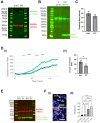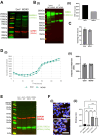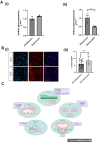Disrupting the interaction between AMBRA1 and DLC1 prevents apoptosis while enhancing autophagy and mitophagy
- PMID: 39469809
- PMCID: PMC11625884
- DOI: 10.1242/bio.060380
Disrupting the interaction between AMBRA1 and DLC1 prevents apoptosis while enhancing autophagy and mitophagy
Abstract
AMBRA1 has critical roles in autophagy, mitophagy, cell cycle regulation, neurogenesis and apoptosis. Dysregulation of these processes are hallmarks of various neurodegenerative diseases and therefore AMBRA1 represents a potential therapeutic target. The flexibility of its intrinsically disordered regions allows AMBRA1 to undergo conformational changes and thus to perform its function as an adaptor protein for various different complexes. Understanding the relevance of these multiple protein-protein interactions will allow us to gain information about which to target pharmacologically. To compare potential AMBRA1 activation strategies, we have designed and validated several previously described mutant constructs in addition to characterising their effects on proliferation, apoptosis, autophagy and mitophagy in SHSY5Y cells. AMBRA1TAT, which is a mutant form of AMBRA1 that cannot interact with DLC1 at the microtubules, produced the most promising results. Overexpression of this mutant protected cells against apoptosis and induced autophagy/mitophagy in SHSY5Y cells in addition to enhancing the switch from quiescence to proliferation in mouse neural stem cells. Future studies should focus on designing compounds that inhibit the protein-protein interaction between AMBRA1/DLC1 and thus have potential to be used as a drug strategy for neurodegeneration.
Keywords: Apoptosis; Autophagy; Mitophagy; Neurodegeneration.
© 2024. Published by The Company of Biologists Ltd.
Conflict of interest statement
Competing interests All authors are employees and shareholders of Merck & Co., Inc., Rahway, NJ, USA.
Figures




References
-
- Cianfanelli, V., Fuoco, C., Lorente, M., Salazar, M., Quongamatteo, F., Gherardini, P. F., De Zio, D., Nazio, F., Antionioli, M., D‘Orazio, N.et al. (2015). AMBRA1 links autophagy to cell proliferation and tumorigenesis by promoting c-Myc dephosphorylation and degradation. Nat. Cell Biol. 17, 20-30. 10.1038/ncb3072 - DOI - PMC - PubMed
-
- Di Bartolomeo, S., Corazzari, M., Nazio, F., Oliverio, S., Lisi, G., Antionoli, M., Pagliarini, V., Matteoni, S., Fuoco, C., Giunta, L.et al. (2010). The dynamic interaction of AMBRA1 with the dynein motor complex regulates mammalian autophagy. J. Cell Biol. 191, 155-168. 10.1083/jcb.201002100 - DOI - PMC - PubMed
Publication types
MeSH terms
Substances
Grants and funding
LinkOut - more resources
Full Text Sources
Research Materials

